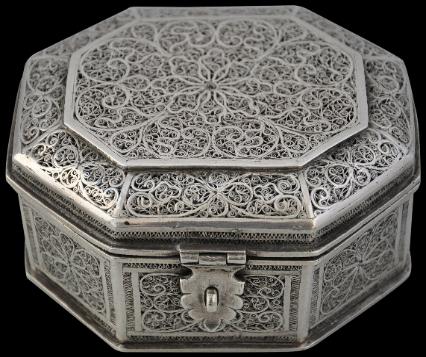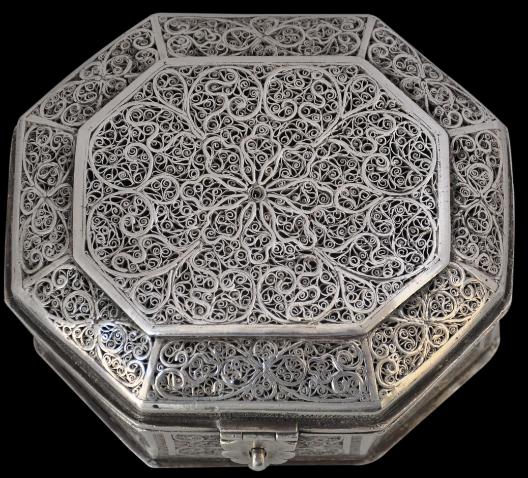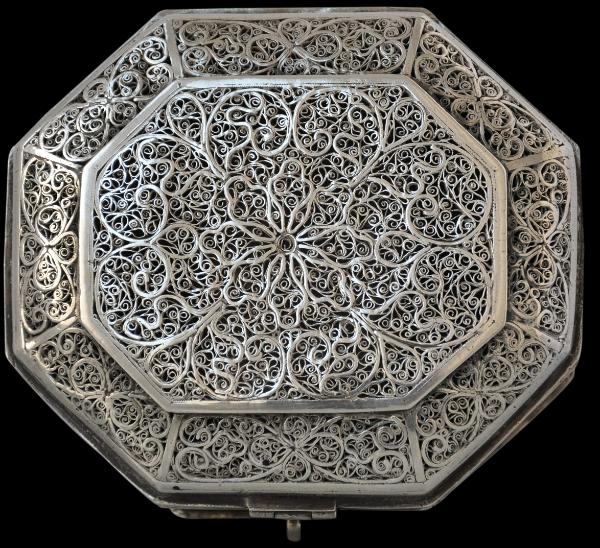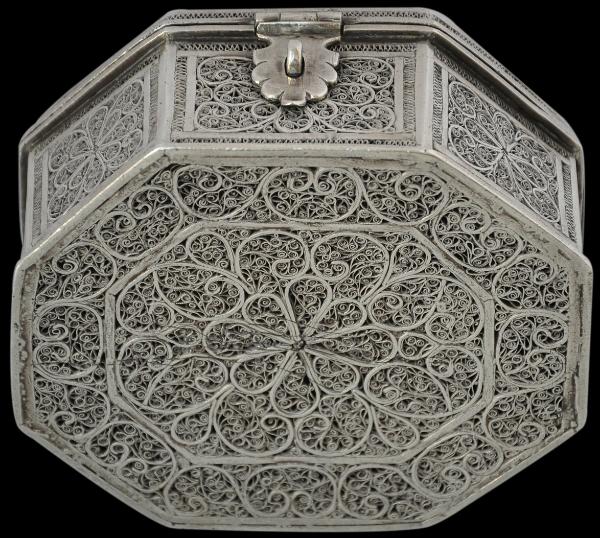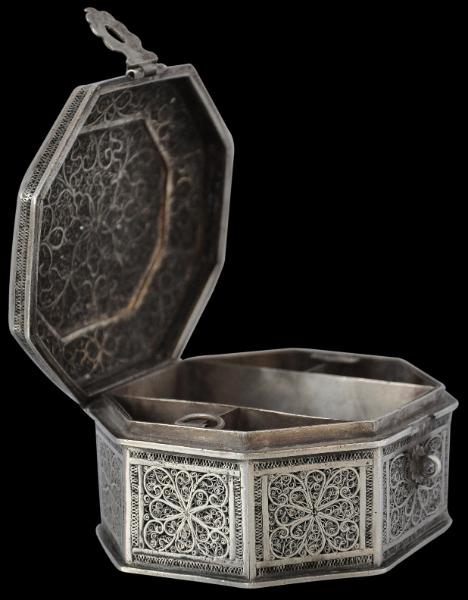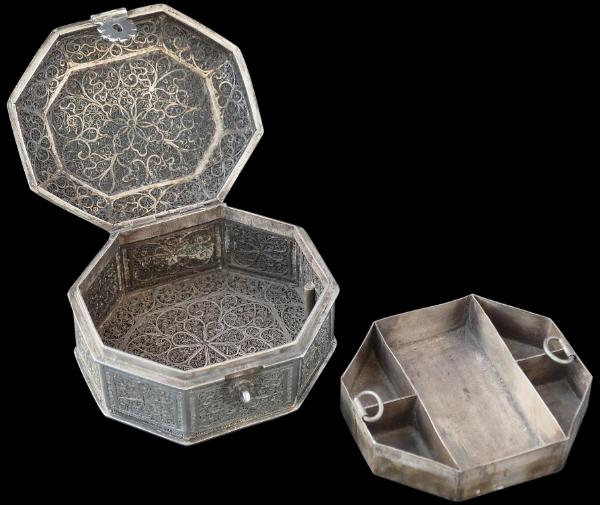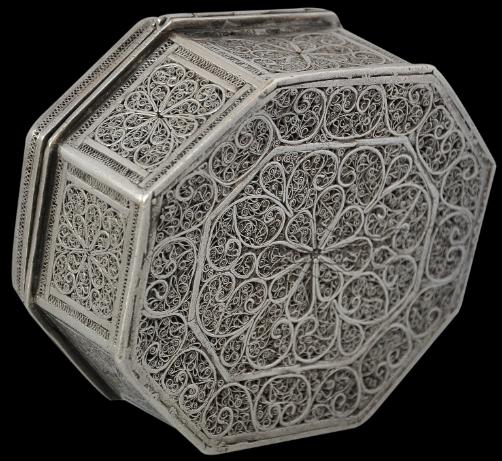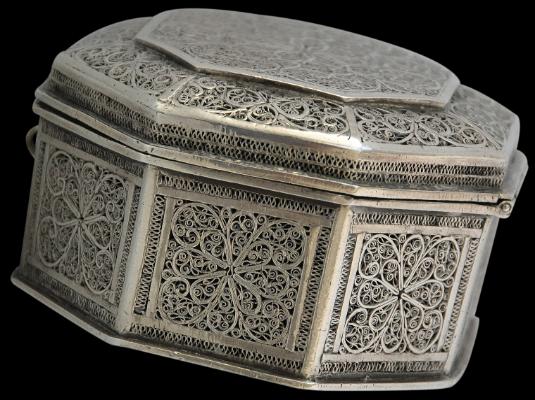This splendid, eight-sided silver filigree pandan or betel box, most probably made in colonial Dutch Batavia for the Indian market, or made in India itself, is beautifully decorated on the hinged, raised cover with a scrolling Indian lotus design – the type of design emulated by Chinese porcelain makers on vases and other export porcelain wares. The panels along the sides and the base also are as intricately decorated with stylised flowerhead designs.
One of the astounding features of this box is the craftsmanship that has gone into the base as well – rather than being of plain sheet silver, it is as elaborately crafted as any other surface on this remarkable box.
The filigree features a mixture of flatter, thicker wires that form the outline of the designs. The remaining spaces are filled in with finer, twisted and curled silver wires.
The combination of wide, flattened wire components with fine twisted filigree work is found on articles often ascribed to Goa of the second half of the seventeenth century – see Menshikova (2006, p. 43) for two examples, and Levenson (2007, p. 263-4) for others. Menshikova refers to filigree items of this type as having been made by ‘Chinese masters in India or Southeast Asia’ in the seventeenth century, which leaves open the possibility that such items might have been made in Batavia perhaps, and most probably traded by the Dutch East India Company (VOC). Two caskets that also show the flattened and fine filigree wire mix are illustrated in Museo de Sao Roque (2006, p. 212 and p. 214). Both are attributed simply to India. Karimnagar is another possible place of manufacture where the style of filigree work is not unlike that attributed to Goa. The ‘Chinese’ nature of the design, particularly in the top of the box, means that China itself cannot be definitely ruled out as the place of origin. Certainly a silver filigree salver in the Hermitage Museum, St Petersburg, and illustrated in Menshikova (p. 38) which has very similar filigree work is ascribed to mid-17th century China.
Importantly, the interior of the box retains its internal tray that has been fitted to permit use as a pandan. Indeed, the presence of the tray makes this box particularly important as it confirms its original intention for use as a betel box or pandan. The tray has dividers which segment the tray into five compartments. It has ring pulls on either side allowing it to be lifted completely from the box. One suspects that many such boxes will have lost their internal trays over the years, these being melted for their bullion value.
The hinged latch is of serrated, flat silver pendant design. A silver filigree chest ascribed to mid-17th century Goa, illustrated in Levenson (2007, p. 264) has a similar solid pendant latch.
A seventeenth century dating is likely, but there is the possibility of an even earlier dating: a silver filigree chest that employs similar construction techniques and which is in Lisbon’s Orient Museum has been attributed to 16th or 17th century Goa (Curvelo et al, 2008).
In terms of condition, the box has a wonderful patina and rounded contours softened by the years and from use. There are no obvious areas of loss to the filigree and no repairs. Light surface scratching is consistent with age. Overall, this is a superb piece which is surprisingly heavy in the hand.
References
Curvelo, A., et al, The Orient Museum, Lisbon, Reunion des Musees Nationaux, 2008.
Jordan, A. et al, The Heritage of Rauluchantim, Museu de Sao Roque, 1996.
Levenson. J. (ed), Encompassing the Globe: Portugal and the World in the 16th and 17th Centuries, Arthur M. Sackler Gallery, 2007.
Menshikova, M., Silver – Wonders from the East: Filigree of the Tsars, Hermitage Amsterdam, 2006.


